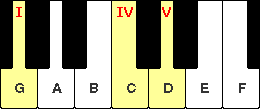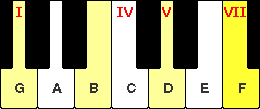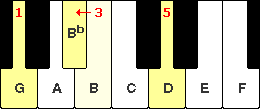

 |
 |
See also, Part 1 - the major chord explained
In bluegrass, country, blues and rock music it's common for the arrangements to have what is referred to as the I-IV-V relationship. Roman numerals are commonly used to designate the chords in a key. This relationship presents an initial steep rise in pitch, followed by a single step then a reduction back down in pitch to the tonic chord. The diagram of the keyboard below illustrates G as the I, C as the IV and D as the V.

The I-IV-V pattern can start at any chord, but since most bluegrass music is in the key of G, it's usually G, C and D. Now, you might be wondering why you've often seen G, C and D7? Well, if the tonic chord is the most important chord, then the 5th (V) is the second most important chord. That is because it leads the music back towards the tonic. When you change the V into a seventh it adds more tension as it resolves back to the tonic.
To find the seventh, count 1.5 whole-steps (3 half-steps) up from the 5th. The following diagram shows the G chord with F as the seventh.

I'll explain minors in more detail later in Keys Explained but for now we'll just stick to the mechanics. To make a major into a minor, drop the 3rd by one half-step. For example, to make a Gm chord (remembering the 1st, 3rd and 5th of G major is G, B and D) dropping the 3rd turns the B into a B flat. The diagram below illustrates this change.

To see how to play minors and sevenths in different locations on the banjo neck, see Banjo Chord Inversions.